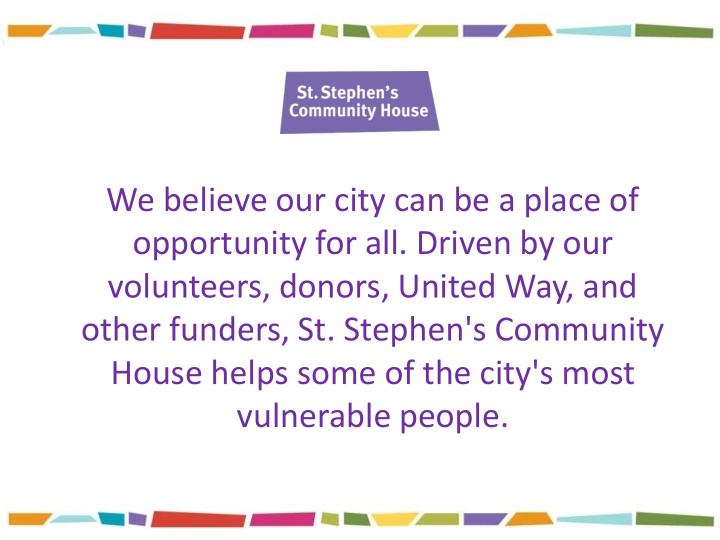



We believe our city can be a place of opportunity for all. Driven by our volunteers, donors, United Way, and other funders, St. Stephen's Community House helps some of the city's most vulnerable people.
We help: • homeless and marginally-housed men and women break the cycle of poverty • people find and keep jobs • youth learn and grow on their way to adulthood • seniors stay in their own homes • newcomers adjust to life in Canada • people resolve conflicts
We are committed to identifying and tackling the root causes, not just the problems our clients and communities face. We believe in a bold vision of Toronto, a vision of a strong, vital, socially progressive and prosperous city. When community comes together, so do the possibilities for all.
As an Employment Ontario Provider, we are proud to support the most distanced from the labour market and achieve a 69% employed outcome and 16% return to education / training outcome
For 2018-19, our profile included: • 45% were Ontario Works or Ontario Disability Support Program Recipients or dependents • 12% identified as having a disability • 52% were out of work or school for more than 6 months • 45% have Grade 12 education or less
Our Catchment Area Selections St. Stephen’s would be interested in Toronto, York and Peel catchment areas. We have a long history (35 plus years) of providing impactful employment services in Toronto. We have strategic partnerships that have allowed us to excel in serving job seekers that are distant from the labour market and employers to meet their hiring needs.
Proposed Catchment Feedback • The proposal of each region being a singular catchment with only one SSM servicing each one is challenging • These areas are densely populated and have very diverse needs in their many neighbourhoods that require variations in service delivery
Proposed Catchment Feedback We strongly encourage the Ministry divide Toronto into a minimum of four catchment areas. Why? - Population density - Uniqueness of communities within Toronto’s Borders 8
SSM Selection Process St. Stephen’s approach to community work has and continues to be one of partnership and collaboration. We believe that to fully meet the needs of the community, partnerships are vital as they bring expertise to fully support all client groups and have connections / relationships with employers, industry and other stakeholders.
St. Stephen’s Approach to being a SSM Our approach to the SSM role would be to build a consortium. We would reach out to key stakeholders in each catchment area. This would best serve each community’s local needs by allowing for the true integration of existing expertise. We would facilitate the sharing of best practices and learning.
What do we mean by Consortium? • We would bring together stakeholder agencies to form a new legal entity • Each member would be equal partners in governance, and development and implementation of the new service model • It would provide open, collaborative forum for co-development • It would effectively leverage all community expertise
Our Recommendations for the SSM Selection Process • Clear communication and transparency with the process is not only important for potential SSM candidates but also for the sector • MTCU needs to continue to ask for feedback and input from key stakeholders and be committed to taking this input and incorporate it into the process.
Our Recommendations for the SSM Selection Process We recommend the selection process equally weigh community connections and understanding with that of the ability to deliver the administration side of the role – that is the capacity to set up ‘shop’ quickly. Along with the expertise of getting positive results working with the most barriered clients to employment.
Our Strategies to Minimize Client Disruption • The current system and the operation of its providers would need to continue to exist to provide service while the transition happens and till the new model is fully operational • Funding would need to be provided and the transition must be gradual .
Our Strategies to Minimize Client Disruption • Clear communication and transparency around the transition by the Ministry to all stakeholders • SSMs need to work with current providers to develop transition plans to the new model and to support new providers to create ramp up plans • Onus needs to be on the SSM to work with the existing service providers to keep key staff in place to continue to support clients
Our Hopes with the SSM Role • Each community works collaboratively to better meet local needs • Collaboration and service integration between providers will happen • Best practices are shared and used across regions • CaMS would stay as the province wide database and reports will still be provided by EOIS
Our Fears with the SSM Role • Private players enter the market that lack the understanding of their communities and their needs (only work with least barriered from employment) • Quick set up and low cost administration is valued over community partnership, expertise working with most barriered and lack of collaboration
Thank you for your time Any questions We look forward to hearing about the next stages of the SSM implementation 18
Recommend
More recommend